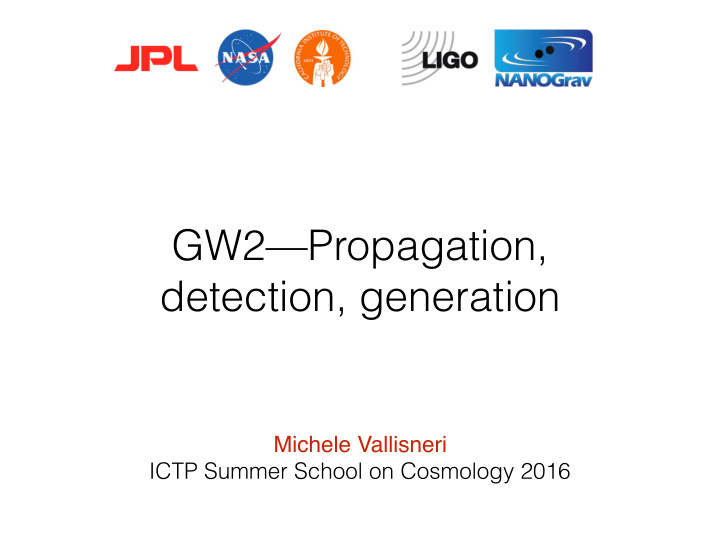



GW2—Propagation, detection, generation Michele Vallisneri ICTP Summer School on Cosmology 2016
Things to learn today 1. In general relativity, curvature propagates like a wave, at the speed of light 2. GWs act as tidal forces in a local Lorentz frame — OR, equivalently — GWs modulate the proper distance between nearby freely falling particles 3. GWs are transverse and quadrupolar 4. GWs carry energy–momentum, although it can be localized only approximately 5. GWs are emitted by time-dependent mass quadrupoles 6. GWs cause the accelerating inspiral of binary stars
Metric theories of gravity: parallel transport
The Riemann tensor
The first Bianchi identity and other Riemann symmetries R αβγδ = − R βαγδ R αβγδ = − R αβδγ R αβγδ = R γδαβ
The second Bianchi identity
Ricci, Ricci, and Einstein
Metric perturbation, linearized theory infinitesimal coordinate transformation invariant!
Riemann propagates as a wave ⇤ R αβγδ = 0
Geodesic deviation You simply fell, inde fj nitely, for an inde fj nite length of time. I went down into the void, to the most absolute bottom conceivable, and once there I saw that the extreme limit must have been much, much farther below, very remote, and I went on falling, to reach it. Since there were no reference points, I had no idea whether my fall was fast or slow. Now that I think about it, there weren't even any proofs that I was really falling: perhaps I had always remained immobile in the same place, or I was moving in an upward direction; since there was no above or below these were only nominal questions and so I might just as well go on thinking I was falling, as I was naturally led to think. Assuming then that one was falling, everyone fell with the same speed and rate of acceleration; in fact we were always more or less on the same level: I, Ursula H'x, Lieutenant Fenimore. Italo Cal v ino, “Cosmicomics” (1965)
Geodesic deviation Newtonian ζ μ ( τ ) for particle at rest in proper reference frame
Gravito-electromagnetism, tendexes, vortexes vortex tendex
Effect on particles (any metric theory) ∂ 2 h gw δ x j = 1 jk jk x k 2 h gw = − 2 R 0 j 0 k ∂ t 2 local inertial frame R 0 j 0 k ( t − z ) plane wave along z six independent degrees of freedom
Effect on particles (general relativity)
Effect on particles (general relativity)
Quasi-Lorentz TT frame (global!) ds 2 = − dt 2 + (1 + h + ) dx 2 + (1 − h + ) dy 2 + 2 h × dxdy + dz 2 particles at rest have constant TT coordinates, but proper distances change (coordinates are stretched) ( ) compare with proper reference frame ds 2 = − (1 + R j 0 k 0 x j x k ) dt 2 − 4 3 R jkl 0 x k x l dtdx j + ( δ ij − 1 3 R ijlm x l x m ) dx i dx j
GW energy-momentum can be defined in a two-lengthscale expansion
GW energy-momentum can be defined in a two-lengthscale expansion =0.3 W/m 2
Quadrupole formula for slow-moving, non-selfgravitating system Lorenz gauge
Quadrupole formula for slow-moving, non-selfgravitating system for a wave propagating along z, computing Riemann shows that the only tidal-field components are h xx = –h yy and h xy ; then we obtain h TT simply by projecting out all other elements
Quadrupole formula for slow-moving, weakly/strongly gravitating system near zone: Newtonian metric wave zone self-gravitating system w e a o k u - t fi g e o l d i n g r e - g w i a o v n e : m e t r i c
Quadrupole formula for slow-moving, weakly gravitating system strongly metric very accurately Newtonian in near zone not valid for strongly gravitating systems; extract Newtonian potential in near zone postulating an outgoing-wave solution in the weak-field region given by matches the near-zone metric if quadrupoles match, hence
GW emission from binary
Adiabatic inspiral 2x10 53 W time to coalescence energy balance restricted waveform
3.5PN waveform (circular, adiabatic) x = v 2 equal-mass BBH Inspiral: merger: PN equations numerical ringdown: relativity perturbation theory
Things we learned today 1. In general relativity, curvature propagates like a wave, at the speed of light 2. GWs act as tidal forces in a local Lorentz frame — OR, equivalently — GWs modulate the proper distance between nearby freely falling particles 3. GWs are transverse and quadrupolar 4. GWs carry energy–momentum, although it can be localized only approximately 5. GWs are emitted by time-dependent mass quadrupoles 6. GWs cause the accelerating inspiral of binary stars
Recommend
More recommend